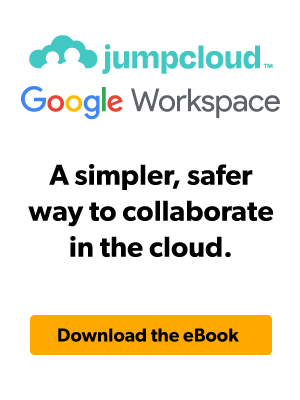Let’s talk about Google Workspace, the go-to platform for more than 3 billion users and 9 million paying organizations worldwide. Many of these organizations are eager to move their entire operation to the cloud.
Here’s the deal: Google Workspace is fantastic for ditching Microsoft Exchange as your email provider and waving goodbye to Microsoft 365 (you know, the old Office and Office 365). However, there’s a catch.
Some essential components of your organization might still be hanging out on premises, and they’re often tied to Microsoft.
When it comes to Google Workspace, one big question IT admins face is what to do with their directory services.
You see, many IT organizations rely on Microsoft Active Directory or LDAP as their identity provider (IdP). And guess what? Lots of IT folks are keen on integrating Google Workspace with OpenLDAP.
Google Workspace and OpenLDAP Integration Can Be Tough
LDAP is one of the most essential authentication protocols. Originally co-authored by JumpCloud Advisor Tim Howes, the LDAP protocol is the centerpiece of the open-source solution OpenLDAP. The technology is an authentication approach that has stood the test of time over almost 30 years.
As a popular directory service, many organizations would like to integrate their OpenLDAP instance with their Google Workspace implementation. To enable the integration, IT admins need to implement Google Cloud Directory Sync (GCDS) (formerly called Google Apps Directory Sync) to make it work.

Of course, it’s a one-way integration given Google’s approach to directory services. You can export your data into Google Workspace.
However, this sync does not let you export your identity data from Google or passwords from Google Workspace. The integration requires an additional server and is fairly brittle. As a result, it’s not widely liked by IT admins.
Also, OpenLDAP’s flexibility can be challenging for less tech-savvy IT admins. Configuring the server, managing app dependencies, modifying directory data or schema, and maintaining directory integrity can be complex tasks as the business scales and changes.
There’s an Easier Way
A different and more popular approach to integrating Google Workspace and OpenLDAP exists. It’s called the JumpCloud Directory Platform. It creates a cloud-hosted directory platform that does not require another server, IT management, or babysitting.
JumpCloud offers a cloud-based directory service that helps IT admins manage different Google Workspace accounts, client systems, networks, and applications from a single console.

In the JumpCloud Admin Portal, administrators can securely and regularly sync multiple Google Workspace instances. This means they can import existing users and export new ones to the specific Google Workspace account they want, making it easier to manage and integrate everything smoothly.
Here’s how the process works:
1. IT organizations leverage JumpCloud as their core user management platform.
2. Users and credentials stored within the JumpCloud identity provider are then synced with Google Workspace.
3. A new user can be created in the central, authoritative user management platform, which subsequently updates Google Workspace.
4. A user deleted in JumpCloud is also suspended in Google Workspace.
5. Passwords are updated on a user’s Windows or Mac machine effectively eliminating the risk of phishing attacks that plague major web applications such as Google Workspace.
Robust and Flexible Functionality
While the integration with Google Workspace and JumpCloud provides the same function as with OpenLDAP through GCDS, it offers a lot more too.
Not only is a cloud directory platform far more resilient, but it’s also API driven by the JumpCloud service. IT organizations get a complete hosted cloud directory service instead of a self-managed, on-prem LDAP implementation plus extra servers for integration.
This bundled solution allows IT admins to easily benefit from the main features of Google Workspace’s productivity and collaboration tools, along with JumpCloud’s open directory platform.
It eliminates the need for complex integrations and ensures a seamless experience. Moreover, the partnership offers a flexible infrastructure that ensures IT environments can adapt and grow over time without any trouble, making them future-proof.
With JumpCloud, Google Workspace organizations can federate their Google identities to their Windows, macOS, and Linux machines, AWS servers, VPNs, web applications, Wi-Fi authentication, and LDAP-based applications hosted on-prem, among others.
Combine the JumpCloud Directory Platform with Google Workspace, and you get a powerful and affordable solution for IT admins. It’s much simpler to set up and use compared to traditional single-vendor options.
By bringing together the productivity features of Google Workspace and a cloud-based open directory platform, it creates a modern solution for collaboration, identity management, access control, and device management. This means you don’t have to deal with multiple-point solutions that can slow down your IT environment.
Stress-Free Google Workspace and OpenLDAP Integration
OpenLDAP offers great flexibility for experienced IT administrators, which makes it an excellent option for organizations with specific niche requirements. Moreover, it’s compatible with almost all operating systems and platforms, making it a popular choice for organizations that utilize or intend to utilize Mac, Linux, or other similar systems.
Want to learn more about integrating Google Workspace with OpenLDAP?
Our cloud directory platform solves common integration challenges without requiring organizations to have their own OpenLDAP server or GCDS. Sign up for a free trial to explore for yourself.





